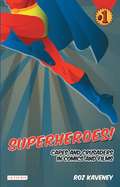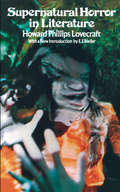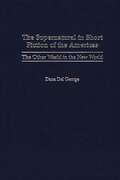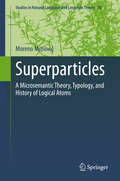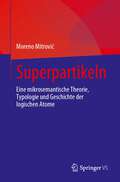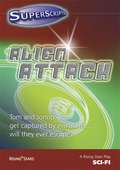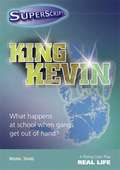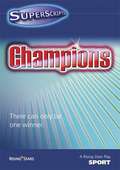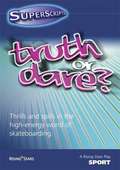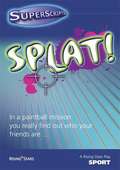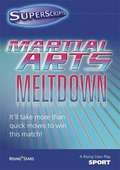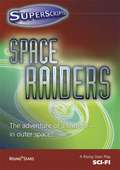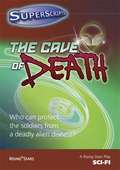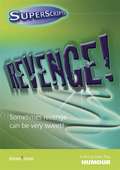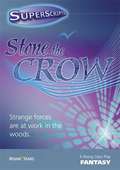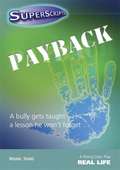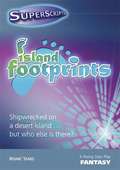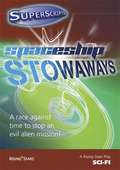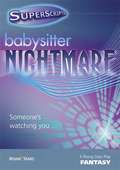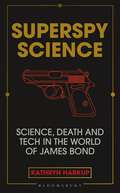- Table View
- List View
Superheroes!: Capes and Crusaders in Comics and Films
by Roz KaveneyModern myths, cheap trash or the objects of fetishist desire?Most people know something about Superman, Batman, Spider-Man and Wonder Woman, even if what they know is heavily filtered through film and television versions, rather than the comics in which they first appeared. Yet, even though the continuity of the DC and Marvel Comics universes rival or surpass in size almost anything else in Western culture, surprisingly little attention has been paid to comics, which we were supposed to grow out of. In 'Superheroes!', acclaimed cultural commentator Roz Kaveney argues that this is a mistake, that, at their best, superhero comics are a form in which some writers and artists are doing fascinating work, not in spite of their chosen form, but because of it. 'Superheroes!' discusses the slow accretion of comics universes from the thirties to the present day, the ongoing debate within the conventions of the superhero comic about whether superheroes are a good thing and the discussion within the comics fan community of the extent to which superhero comics are disfigured by misogyny and sexism. Roz Kaveney attempts to explain the differences between Marvel and DC, the notion of the floating present ( or why Spider-Man, fifteen when he adopted the costume, is still only in his early thirties), and the various attempts by both companies to re-invent and re-boot individual characters and their entire continuity universes. She also looks at the influence of comics on the group of film and television screenwriters she calls 'the fanboy creators', all of whom moonlight as comics script writers, using Joss Whedon as her case study, and examines the adaptation of well-known comics into large-budget feature films, not always to the advantage of the material.
Supernatural Creatures in Arabic Literary Tradition (Routledge Focus on Literature)
by Ahmed Al-RawiThis volume explores the cultural meaning of several supernatural creatures in Arabia, tracing the historical development of these creatures and their recent representations in the Western world. Utilizing a variety of old and new Arabic, English and French sources, the text explores creatures including the Ghoul and its derivations, the Rukh bird, and the dragon. Unlike other texts, which primarily focus on Genies or Jinns, this volume explores other supernatural and mythical creatures that have been popular in the Middle East and Arabia for centuries but are less known to Western audiences. Dr. Al-Rawi argues that many of these creatures have pre-Islamic roots, and that they served an important function in connecting the past with the present, offering a popular vehicle to articulate and imagine the supernatural dimension of existence which helps in consolidating religious views.
Supernatural Creatures in Arabic Literary Tradition (Routledge Focus on Literature)
by Ahmed Al-RawiThis volume explores the cultural meaning of several supernatural creatures in Arabia, tracing the historical development of these creatures and their recent representations in the Western world. Utilizing a variety of old and new Arabic, English and French sources, the text explores creatures including the Ghoul and its derivations, the Rukh bird, and the dragon. Unlike other texts, which primarily focus on Genies or Jinns, this volume explores other supernatural and mythical creatures that have been popular in the Middle East and Arabia for centuries but are less known to Western audiences. Dr. Al-Rawi argues that many of these creatures have pre-Islamic roots, and that they served an important function in connecting the past with the present, offering a popular vehicle to articulate and imagine the supernatural dimension of existence which helps in consolidating religious views.
Supernatural Horror in Literature (Classics To Go)
by Howard Phillips LovecraftH. P. Lovecraft (1890–1937), the most important American supernaturalist since Poe, has had an incalculable influence on all the horror-story writing of recent decades. Although his supernatural fiction has of late been enjoying an unprecedented fame, it is still not widely known that he wrote a critical history of supernatural horror in literature that has yet to be superseded as the finest historical discussion of the genre. This extraordinary work is presented in this volume in its final, revised text.With incisive penetration and power, Lovecraft here formulates the aesthetics of supernatural horror, and summarizes in masterful fashion the range of its literary expression from primitive folklore to the tales of his own 20th-century masters. Following a discussion of terror-literature in ancient, medieval and renaissance culture, he launches on a critical survey of the whole history of horror fiction from the Gothic school of the 18th century (when supernatural horror finally found its own genre) to the time of De la Mare and M. R. James. The Castle of Otranto, Radcliffe, "Monk" Lewis, Fathek, Charles Brockden Brown, Melmoth the Wanderer, Frankenstein, Bulwer-Lytton, Fongué's Undine, Wuthering Heights, Poe (an entire chapter), The House of the Seven Gables, de Maupassant's Horla, Bierce, The Turn of the Screw, M. P. Shiel, W. H. Hodgson, Machen, Blackwood, and Dunsany are among the authors and works discussed in depth. Lovecraft also notices a host of lesser supernatural writers — enough to draw up an extensive reading list.By charting so completely the background for his own concepts of horror and literary techniques, Lovecraft throws light on his own fiction as well as on the horror literature which has followed in his influential wake. For this reason this book will be especially intriguing to those who have read and enjoyed Lovecraft's fiction as an isolated phenomenon. These and other readers, searching for a guide through the inadequately marked region of literary horror, need search no further. New introduction by E. F. Bleiler.
The Supernatural in Short Fiction of the Americas: The Other World in the New World (Contributions to the Study of Science Fiction and Fantasy)
by Dana Del GeorgeThe continuing cultural encounters of the Americas, between European and indigenous cultures, and between scientific materialism and premodern supernaturalism, have originated new narrative forms. While supernatural short fiction of the Americas belongs to the broad category of the fantastic, which is generally approached synchronically, reading audiences of the past 200 years have shifted their beliefs about the supernatural several times. While nineteenth-century readers understood science as real and the supernatural as imaginary, modern audiences recognize both as inaccurate, a shift which allows authors of supernatural fiction to celebrate premodern indigenous beliefs which were once disdained by a materialist culture.This book situates supernatural short fiction of the Americas within the changing cultural and epistemological contexts of the last 200 years and explores how authors have drawn upon a wealth of indigenous traditions. The book begins with a discussion of theories of the supernatural and the fantastic. It then looks at some of the first encounters of European and Native American supernatural beliefs and points to the common elements of these early traditions. The volume next focuses on American literature of the nineteenth century, which has a complex fusion of materialist biases and metaphysical fascinations. The final portion of the book gives greater attention to Spanish-American literature and the blending of the supernatural with attitudes of nostalgia and uncertainty.
The Supernatural Media Virus: Virus Anxiety in Gothic Fiction Since 1990 (Gegenwartsliteratur #4)
by Rahel Sixta SchmitzSince the 1990s, the virus and the network metaphors have become increasingly popular, finding application in a broad range of everyday discourses, academic disciplines, and fiction genres. In this book, Rahel Sixta Schmitz defines and discusses a trope recurring in Gothic fiction: the supernatural media virus. This trope comprises the confluence of the virus, the network, and a deep, underlying media anxiety. This study shows how Gothic narratives such as House of Leaves or The Ring feature the supernatural media virus to negotiate as well as actively shape imaginations of the network society and the dangers of a globalized, technologized world.
Superparticles: A Microsemantic Theory, Typology, and History of Logical Atoms (Studies in Natural Language and Linguistic Theory #98)
by Moreno MitrovićThis book is all about the captivating ability that the human language has to express intricately logical (mathematical) meanings using tiny (microsemantic) morphemes as utilities. Languages mark meanings with identical inferences using identical particles and these particles thus creep up in a wide array of expressions. Because of their multi-tasking capacity to express seemingly disparate meanings, they are dubbed Superparticles. These particles are perfect windows into the interlock of several grammatical modules and the nature of the interaction of these modules through time. With a firm footing in the module where grammatical bones are built and assembled (narrow morpho-syntax), superparticles acquire varied interpretation (in the conceptual-intentional module – semantics) depending on the structure they fea- ture in. What is more, some of the interpretations these particles trigger are inferential and belong, under the standard account, to the realm of pragmatics. How can such tiny particles, rarely exceeding a syllable of sound, have such powerful and over-arching effects across the inter-modular grammatical space? This is the Platonic background against which this book is set.
Superpartikeln: Eine mikrosemantische Theorie, Typologie und Geschichte der logischen Atome
by Moreno MitrovićIn diesem Buch geht es um die faszinierende Fähigkeit der menschlichen Sprache, mit Hilfe winziger (mikrosemantischer) Morpheme als Hilfsmittel komplizierte logische (mathematische) Bedeutungen auszudrücken. Sprachen markieren Bedeutungen mit identischen Schlussfolgerungen, indem sie identische Partikel verwenden, und diese Partikel schleichen sich so in eine Vielzahl von Ausdrücken ein. Aufgrund ihrer Multitasking-Fähigkeit, scheinbar disparate Bedeutungen auszudrücken, werden sie als Superpartikel bezeichnet. Diese Partikel sind perfekte Fenster in die Verzahnung mehrerer grammatischer Module und die Art der Interaktion dieser Module im Laufe der Zeit. Fest verankert in dem Modul, in dem die grammatischen Knochen gebaut und zusammengesetzt werden (enge Morphosyntax), erhalten Superpartikel je nach der Struktur, in der sie vorkommen, unterschiedliche Interpretationen (im begrifflich-intentionalen Modul - Semantik). Darüber hinaus sind einige der Interpretationen, die diese Partikel auslösen, inferentiell und gehören nach der Standardrechnung in den Bereich der Pragmatik. Wie können so winzige Partikel, die selten länger als eine Silbe sind, so mächtige und übergreifende Wirkungen im intermodularen grammatischen Raum haben? Dies ist der platonische Hintergrund, vor dem dieses Buch steht.
SuperScripts: Alien Attack (PDF)
by Catherine BakerThe 'SuperScripts' series will help ensure a supportive reading experience for struggling readers. The books have a reading age of six to seven, but are written to appeal to boys and girls from nine to 13 years and over.
SuperScripts: King Kevin (PDF)
by Paul BlumThe 'SuperScripts' series will help ensure a supportive reading experience for struggling readers. The books have a reading age of six to seven, but are written to appeal to boys and girls from nine to 13 years and over.
SuperScripts: Champions (PDF)
by Helen ChapmanThe 'SuperScripts' series will help ensure a supportive reading experience for struggling readers. The books have a reading age of six to seven, but are written to appeal to boys and girls from nine to 13 years and over.
SuperScripts: Truth or Dare? (PDF)
by Helen ChapmanThe 'SuperScripts' series will help ensure a supportive reading experience for struggling readers. The books have a reading age of six to seven, but are written to appeal to boys and girls from nine to 13 years and over.
SuperScripts: Splat! (PDF)
by Helen ChapmanSuperscripts is a series of six-part plays for less able readers. Each play features four bite-sized scenes, written for 10 to 15 minute reading sessions. All the parts are written for pupils at reading level 6 to 7 years, and there are six parts per play allowing teachers to engage a reading group of up to six.
SuperScripts: Martial Arts Meltdown (PDF)
by Helen ChapmanEach book in this series contains four bite-sized scenes written for 10 to 15 minute reading sessions. All parts are written at the same reading level - 6 to 7 years - and will appeal to boys and girls.
SuperScripts: Space Raiders (PDF)
by Simon CheshireThe 'SuperScripts' series will help ensure a supportive reading experience for struggling readers. The books have a reading age of six to seven, but are written to appeal to boys and girls from nine to 13 years and over.
SuperScripts: The Cave of Death (PDF)
by Simon CheshireSuperscripts is a series of six-part plays for less able readers. Each play features four bite-sized scenes, written for 10 to 15 minute reading sessions. All the parts are written for pupils at reading level 6 to 7 years, and there are six parts per play allowing teachers to engage a reading group of up to six.
SuperScripts: Revenge! (PDF)
by Simon CheshireSuperscripts is a series of six-part plays for less able readers. Each play features four bite-sized scenes, written for 10 to 15 minute reading sessions. All the parts are written for pupils at reading level 6 to 7 years, and there are six parts per play allowing teachers to engage a reading group of up to six.
SuperScripts: Stone The Crow (PDF)
by John GallowaySuperscripts is a series of six-part plays for less able readers. Each play features four bite-sized scenes, written for 10 to 15 minute reading sessions. All the parts are written for pupils at reading level 6 to 7 years, and there are six parts per play allowing teachers to engage a reading group of up to six.
SuperScripts: Payback (PDF)
by Alison HawesThe 'SuperScripts' series will help ensure a supportive reading experience for struggling readers. The books have a reading age of six to seven, but are written to appeal to boys and girls from nine to 13 years and over.
SuperScripts: Island Footprints (PDF)
by Jillian PowellThe 'SuperScripts' series will help ensure a supportive reading experience for struggling readers. The books have a reading age of six to seven, but are written to appeal to boys and girls from nine to 13 years and over.
SuperScripts: Spaceship Stowaways (PDF)
by Jillian PowellEach book in this series contains four bite-sized scenes written for 10 to 15 minute reading sessions. All parts are written at the same reading level - 6 to 7 years - and will appeal to boys and girls.
SuperScripts: Babysitter Nightmare (PDF)
by Shoo RaynerEach book in this series contains four bite-sized scenes written for 10 to 15 minute reading sessions. All parts are written at the same reading level - 6 to 7 years - and will appeal to boys and girls.
Superspy Science: Science, Death and Tech in the World of James Bond
by Kathryn HarkupThe adventures of James Bond have thrilled readers since Ian Fleming's novel Casino Royale was published in 1953, and when the movie of Dr No was released in 1962, Bond quickly became the world's favourite secret agent.Science and technology have always been central to the plots that make up the world of Bond, and in Superspy Science Kathryn Harkup explores the full range of 007's exploits and the arms, technologies, tactics and downfalls of his various foes. From the practicalities of building a volcano-based lair, to whether being covered in gold paint really will kill you, and – if your plan is to take over the world – whether it is better to use bacteria, bombs, or poison – this book has all the answers and more.Could our favourite Bond villains actually achieve world domination? Were the huge variety of weapons and technology in Bond's arsenal from both the films and books ever actually developed in real life? And would 007 actually escape all those close shaves intact? From the plots to the gadgets to the ludicrous ways that his life is threatened, Superspy Science takes an in-depth look at the scientific world of James Bond.
Superstructuralism
by Richard HarlandFirst Published in 2002. Routledge is an imprint of Taylor & Francis, an informa company.
Superstructuralism
by Richard HarlandFirst Published in 2002. Routledge is an imprint of Taylor & Francis, an informa company.
